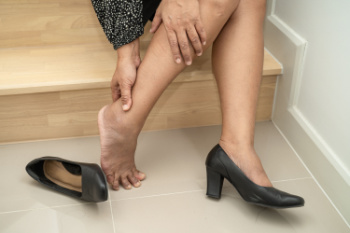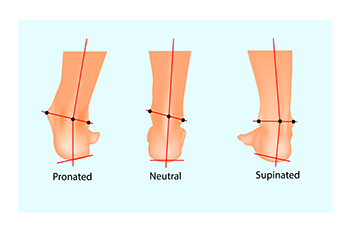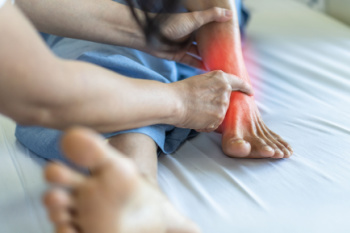
Plantar Fibroma Excision Surgery

A sign a plantar fibroma has developed is a noticeable lump in the arch of the foot. If it becomes painful or uncomfortable, surgery may be considered. In plantar fibroma excision surgery, managing postoperative healing is critical. Closed incision negative pressure therapy, or CINPT, and surgical drain placement are two techniques used for this purpose. CINPT involves applying a sealed dressing connected to a vacuum pump, which continuously removes fluid and reduces edema, promoting faster healing and minimizing infection risk. This method maintains a sterile environment and can improve wound outcomes. On the other hand, surgical drain placement involves inserting a tube into the surgical site to remove fluid buildup. While effective in preventing hematoma or seroma formation, it requires careful monitoring and regular emptying. Drains can sometimes increase the risk of infection and discomfort. Choosing between CINPT and surgical drains depends on the specific needs of the patient and the podiatric surgeon’s preference, with CINPT often providing a more advanced and less invasive option for optimal healing. If you have a plantar fibroma that is causing you pain and discomfort, it is suggested that you consult a podiatrist who can determine which type of surgery is right for you.
Foot surgery is sometimes necessary to treat a foot ailment. To learn more, contact one of our podiatrists of Houston Foot and Ankle Care. Our doctors will assist you with all of your foot and ankle needs.
When Is Surgery Necessary?
Foot and ankle surgery is generally reserved for cases in which less invasive, conservative procedures have failed to alleviate the problem. Some of the cases in which surgery may be necessary include:
- Removing foot deformities like bunions and bone spurs
- Severe arthritis that has caused bone issues
- Cosmetic reconstruction
What Types of Surgery Are There?
The type of surgery you receive will depend on the nature of the problem you have. Some of the possible surgeries include:
- Bunionectomy for painful bunions
- Surgical fusion for realignment of bones
- Neuropathy decompression surgery to treat nerve damage
Benefits of Surgery
Although surgery is usually a last resort, it can provide more complete pain relief compared to non-surgical methods and may allow you to finally resume full activity.
Surgical techniques have also become increasingly sophisticated. Techniques like endoscopic surgery allow for smaller incisions and faster recovery times.
If you have any questions please feel free to contact our offices located in Inner Loop, Southwest, Greater Heights, and Pearland, TX . We offer the newest diagnostic and treatment technologies for all your foot and ankle needs.
Foot and Ankle Surgery
When conservative, noninvasive methods prove ineffective, surgery may be selected as the next course of action for the treatment of your foot or ankle condition. A wide number of foot and ankle surgical procedures exist, and it is up to your podiatrist to determine which intervention will be most appropriate and helpful for your case. Some surgical procedures include bunion surgery, fusion, hammertoe surgery, heel spur surgery, metatarsal surgery, nail surgery, neuroma surgery, reconstructive surgery, skin surgery, and tendon surgery. Typically, surgery is turned to as a definitive way to alleviate excessive pain or discomfort and to return your foot to full mobility.
Regardless of the location on the body, all surgical procedures require preoperative testing and examination to ensure the surgery’s success and preferred outcome. A review of your medical history and medical conditions will take place, as will an evaluation of any current diseases, illnesses, allergies, and medications. Tests such as blood studies, urinalyses, EKG, X-rays, and blood flow studies may be ordered. Because the procedure involves the foot and/or ankle, the structures of your feet while walking may also be observed by your podiatrist.
Care post-surgery will depend on the type of surgical procedure performed. Typically, all postoperative care involves rest, ice, compression, and elevation. To improve and ensure a safe recovery, your foot and ankle surgeon may also employ the use of bandages, splints, surgical shoes, casts, crutches, or canes. He will also determine if and when you can bear weight. A timely and thorough recovery is a priority for both you and your podiatrist, and carefully following postoperative instructions can help achieve this.
Key Signs and Symptoms of Common Foot Conditions

Identifying common foot problems is essential for maintaining optimum foot health and overall mobility. Issues such as bunions, characterized by a bony bump at the base of the big toe, and plantar fasciitis, marked by heel pain due to inflammation, are frequent concerns. Athlete's foot presents with itching, burning, and cracked skin between the toes. Corns and calluses, resulting from repeated pressure or friction, appear as thickened, hardened skin. Ingrown toenails, where the nail grows into the surrounding skin, cause pain and swelling. Foot pain or discomfort, visible deformities, persistent swelling, and changes in skin or nail appearance are clear indicators of these conditions. Early recognition and appropriate treatment, such as wearing proper footwear, maintaining hygiene, and seeking medical advice from a podiatrist are good ways to prevent complications. If you have any type of foot pain or condition, it is suggested that you make an appointment with a podiatrist for an exam and treatment.
Foot Pain
Foot pain can be extremely painful and debilitating. If you have a foot pain, consult with one of our podiatrists from Houston Foot and Ankle Care. Our doctors will assess your condition and provide you with quality foot and ankle treatment.
Causes
Foot pain is a very broad condition that could be caused by one or more ailments. The most common include:
- Bunions
- Hammertoes
- Plantar Fasciitis
- Bone Spurs
- Corns
- Tarsal Tunnel Syndrome
- Ingrown Toenails
- Arthritis (such as Gout, Rheumatoid, and Osteoarthritis)
- Flat Feet
- Injury (from stress fractures, broken toe, foot, ankle, Achilles tendon ruptures, and sprains)
- And more
Diagnosis
To figure out the cause of foot pain, podiatrists utilize several different methods. This can range from simple visual inspections and sensation tests to X-rays and MRI scans. Prior medical history, family medical history, and any recent physical traumatic events will all be taken into consideration for a proper diagnosis.
Treatment
Treatment depends upon the cause of the foot pain. Whether it is resting, staying off the foot, or having surgery; podiatrists have a number of treatment options available for foot pain.
If you have any questions, please feel free to contact our offices located in Inner Loop, Southwest, Greater Heights, and Pearland, TX . We offer the newest diagnostic and treatment technologies for all your foot care needs.
Foot Pain
Our feet are arguably the most important parts of our bodies because they are responsible for getting us from place to place. However, we often don’t think about our feet until they begin to hurt. If you have pain in your feet, you need to first determine where on the foot you are experiencing it to get to the root of the problem. The most common areas to feel pain on the foot are the heel and the ankle.
Heel pain is most commonly attributed to a condition called plantar fasciitis. Plantar fasciitis occurs when the plantar fascia, which is the band of tough tissue connecting the heel bone to the toes becomes inflamed. Plantar fasciitis pain is usually worse in the morning, and it tends to go away throughout the day. If you have plantar fasciitis, you should rest your foot and do heel and foot muscles stretches. Wearing shoes with proper arch support and a cushioned sole has also been proven to be beneficial.
Some common symptoms of foot pain are redness, swelling, and stiffness. Foot pain can be dull or sharp depending on its underlying cause. Toe pain can also occur, and it is usually caused by gout, bunions, hammertoes, ingrown toenails, sprains, fractures, and corns.
If you have severe pain in your feet, you should immediately seek assistance from your podiatrist for treatment. Depending on the cause of your pain, your podiatrist may give you a variety of treatment options.
Effects of Foot Pronation

Foot pronation is a natural movement where the foot rolls inward during walking or running to absorb shock and adapt to surfaces. However, when this inward roll becomes excessive, it leads to a condition known as overpronation. It can result from flat feet or wearing improper footwear, causing the arch to collapse inward excessively. This misalignment may then lead to plantar fasciitis, shin splints, and knee pain, as it puts strain on muscles and tendons in the foot and lower leg. Conversely, underpronation, or supination, occurs when the foot does not roll inward enough, often seen in individuals with high arches. Underpronation can contribute to problems such as ankle sprains due to inadequate shock absorption. A podiatrist can identify both overpronation and underpronation by examining wear patterns on shoes and assessing gait mechanics. Treatment options include custom orthotics, specific exercises, or footwear adjustments to restore proper foot function and prevent future complications. If you have either of these conditions, It is suggested that you schedule an appointment with a podiatrist for an exam and treatment.
If you have any concerns about your feet, contact one of our podiatrists from Houston Foot and Ankle Care. Our doctors can provide the care you need to keep you pain-free and on your feet.
Biomechanics in Podiatry
Podiatric biomechanics is a particular sector of specialty podiatry with licensed practitioners who are trained to diagnose and treat conditions affecting the foot, ankle and lower leg. Biomechanics deals with the forces that act against the body, causing an interference with the biological structures. It focuses on the movement of the ankle, the foot and the forces that interact with them.
A History of Biomechanics
- Biomechanics dates back to the BC era in Egypt where evidence of professional foot care has been recorded.
- In 1974, biomechanics gained a higher profile from the studies of Merton Root, who claimed that by changing or controlling the forces between the ankle and the foot, corrections or conditions could be implemented to gain strength and coordination in the area.
Modern technological improvements are based on past theories and therapeutic processes that provide a better understanding of podiatric concepts for biomechanics. Computers can provide accurate information about the forces and patterns of the feet and lower legs.
Understanding biomechanics of the feet can help improve and eliminate pain, stopping further stress to the foot.
If you have any questions please feel free to contact our offices located in Inner Loop, Southwest, Greater Heights, and Pearland, TX . We offer the newest diagnostic and treatment technologies for all your foot and ankle needs.
Biomechanics in Podiatry
Podiatry is a branch of medicine that deals with the study, diagnosis, and treatment of foot and ankle conditions. There are various subdivisions in podiatry; biomechanics is one of them. Biomechanics is the way in which the bones, muscles, and joints of the feet and lower limb interact with each other.
Our feet play crucial roles in the way we move, and it is rare to have feet that are completely symmetrical. Common biomechanical issues include high or low arches or uneven leg heights. Excessive pronation often leads to fallen arches, or flat feet, and is a common cause of running injuries. People whose feet are over-pronated tend to have flexible and unstable feet. Pain is usually experienced during walking and running.
At times, people may be able to adapt to these abnormalities without any difficulties, but in other cases, these issues can cause a great deal of pain. This pain occurs because the joints, muscles, ligaments, and tendons are put under an excess amount of stress during movement. Common symptoms of biomechanical problems stemming from the feet include hip pain, knee pain, leg cramps, ankle pain, lower back pain, weak ankles, tripping, heel pain, Achilles pain, and shin splints.
Many biomechanical issues can be treated with orthotics. Orthotics are shoe insoles that are used to help control the way the foot operates. They can provide relief from foot pain, heel pain, and knee pain. Depending on your specific case, you may need to purchase over-the-counter orthotics or custom orthotics to fit your feet. Your podiatrist will be able to prescribe the perfect orthotic for your feet to help you walk around with ease.
Gait is defined as the way we move our bodies from one point to another. This is usually done by either walking or running. Gait analysis is a method used to assess the way we walk or run to highlight biomechanical abnormalities. Gait analyses are a great way to take a detailed look at how you walk and how your foot moves while you walk. An examination of the feet will help your podiatrist understand why you are suffering pain in other parts of your body.
What Does Tarsal Tunnel Syndrome Feel Like?
 Tarsal tunnel syndrome is caused by compression of the posterior tibial nerve as it passes through the tarsal tunnel, which is a narrow space on the inside of the ankle. This nerve entrapment can result overuse, injury, inflammation, or structural abnormalities, such as flat feet or varicose veins. Symptoms of tarsal tunnel syndrome include tingling, burning, or shooting pain in the foot and ankle, numbness, and a feeling of electric shocks radiating into the sole. These symptoms often worsen with prolonged standing or walking. Diagnosis involves a physical examination, focusing on the areas of pain and nerve compression, in addition to imaging studies like MRI scans or ultrasounds to identify underlying causes. Nerve conduction studies may also be used to assess the function of the posterior tibial nerve. Relief options include rest, anti-inflammatory medications, and exercises to alleviate symptoms. Orthotic devices can help reduce pressure on the nerve, and in severe cases, surgical intervention may be necessary. Complications from untreated tarsal tunnel syndrome can lead to chronic pain and permanent nerve damage. If you have pain in this part of your foot, it is suggested that you schedule an appointment with a podiatrist for a precise diagnosis and individualized treatment plan.
Tarsal tunnel syndrome is caused by compression of the posterior tibial nerve as it passes through the tarsal tunnel, which is a narrow space on the inside of the ankle. This nerve entrapment can result overuse, injury, inflammation, or structural abnormalities, such as flat feet or varicose veins. Symptoms of tarsal tunnel syndrome include tingling, burning, or shooting pain in the foot and ankle, numbness, and a feeling of electric shocks radiating into the sole. These symptoms often worsen with prolonged standing or walking. Diagnosis involves a physical examination, focusing on the areas of pain and nerve compression, in addition to imaging studies like MRI scans or ultrasounds to identify underlying causes. Nerve conduction studies may also be used to assess the function of the posterior tibial nerve. Relief options include rest, anti-inflammatory medications, and exercises to alleviate symptoms. Orthotic devices can help reduce pressure on the nerve, and in severe cases, surgical intervention may be necessary. Complications from untreated tarsal tunnel syndrome can lead to chronic pain and permanent nerve damage. If you have pain in this part of your foot, it is suggested that you schedule an appointment with a podiatrist for a precise diagnosis and individualized treatment plan.
Tarsal tunnel syndrome can be very uncomfortable to live with. If you are experiencing tarsal tunnel syndrome, contact one of our podiatrists of Houston Foot and Ankle Care. Our doctors can provide the care you need to keep you pain-free and on your feet.
Tarsal Tunnel Syndrome
Tarsal tunnel syndrome, which can also be called tibial nerve dysfunction, is an uncommon condition of misfiring peripheral nerves in the foot. The tibial nerve is the peripheral nerve in the leg responsible for sensation and movement of the foot and calf muscles. In tarsal tunnel syndrome, the tibial nerve is damaged, causing problems with movement and feeling in the foot of the affected leg.
Common Cause of Tarsal Tunnel Syndrome
- Involves pressure or an injury, direct pressure on the tibial nerve for an extended period of time, sometimes caused by other body structures close by or near the knee.
- Diseases that damage nerves, including diabetes, may cause tarsal tunnel syndrome.
- At times, tarsal tunnel syndrome can appear without an obvious cause in some cases.
The Effects of Tarsal Tunnel Syndrome
- Different sensations, an afflicted person may experience pain, tingling, burning or other unusual sensations in the foot of the affected leg.
- The foot muscles, toes and ankle become weaker, and curling your toes or flexing your foot can become difficult.
- If condition worsens, infections and ulcers may develop on the foot that is experiencing the syndrome.
A physical exam of the leg can help identify the presence of tarsal tunnel syndrome. Medical tests, such as a nerve biopsy, are also used to diagnose the condition. Patients may receive physical therapy and prescriptive medication. In extreme cases, some may require surgery.
If you have any questions please feel free to contact our offices located in Inner Loop, Southwest, Greater Heights, and Pearland, TX . We offer the newest diagnostic and treatment technologies for all your foot and ankle needs.
Tarsal Tunnel Syndrome
Tarsal tunnel syndrome is a condition in which there is a compression of the posterior tibial nerve. The posterior tibial nerve runs along the inside of the ankle into the foot. Tarsal tunnel syndrome is named for the tarsal tunnel, which is a thin space along the inside of the ankle beside the ankle bones. This space contains various nerves, arteries, and tendons, and includes the posterior tibial nerve. The tibial nerve is the peripheral nerve in the leg responsible for sensation and movement of the foot and calf muscles. In tarsal tunnel syndrome the tibial nerve is compressed, causing tingling or burning, numbness, and pain.
Common causes of tarsal tunnel syndrome involve pressure or an injury. Injuries that produce inflammation and swelling in or around the tunnel may place pressure on the posterior tibial nerve. Direct pressure on the tibial nerve for an extended period of time, sometimes caused by other body structures close by or trauma to the tibial nerve, can result in tarsal tunnel syndrome. Diseases that damage nerves, such as diabetes or arthritis, may cause tarsal tunnel syndrome. Those with flat feet are at risk for developing the condition, as the extra pressure and strain placed on the foot may compress the posterior tibial nerve.
Feeling different sensations in the foot at different times is a common symptom of tarsal tunnel syndrome. An afflicted person may experience pain, tingling, burning or other unusual sensations in the foot of the affected leg. Symptoms are primarily felt on bottom of the foot and/or the inside of the ankle. Symptoms can appear suddenly and may occur due to overuse of the foot.
To diagnose tarsal tunnel syndrome, your podiatrist may examine the foot and tap the posterior tibial nerve to see if symptoms surface. He or she may also order an MRI to determine if a mass is present.
Treating tarsal tunnel syndrome will depend on the decision of your podiatrist. Multiple options are available, however, and can include rest, ice, immobilization, oral medications such as anti-inflammatory drugs (NSAIDS), physical therapy, injection therapy, orthotics, supportive shoes, braces, and surgery.
How Stretching the Feet Keeps Them Healthy
 Keeping feet in top shape involves regular exercises and stretches that enhance flexibility, strength, and overall health, reducing the risk of injuries. Limbering up with a foot roll using a tennis ball helps massage and loosen the bottom of the foot. The bottom of the foot stretch, where you pull back on the toes while sitting, targets the plantar fascia, easing tension and preventing conditions like plantar fasciitis. The top-of-the-foot stretch is achieved by pointing the toes and gently pressing down, helping to alleviate tension and improve flexibility in the extensor muscles. Calf and Achilles stretches, such as leaning into a wall with one leg extended back, enhance the flexibility and strength of the calf muscles and Achilles tendon, essential for maintaining proper foot mechanics. The seated hamstring stretch, where you reach for your toes while seated, supports the overall flexibility of the leg, reducing strain on the feet. If you would like personalized advice on foot stretches and to address any foot concerns you may have, it is suggested that you consult a podiatrist.
Keeping feet in top shape involves regular exercises and stretches that enhance flexibility, strength, and overall health, reducing the risk of injuries. Limbering up with a foot roll using a tennis ball helps massage and loosen the bottom of the foot. The bottom of the foot stretch, where you pull back on the toes while sitting, targets the plantar fascia, easing tension and preventing conditions like plantar fasciitis. The top-of-the-foot stretch is achieved by pointing the toes and gently pressing down, helping to alleviate tension and improve flexibility in the extensor muscles. Calf and Achilles stretches, such as leaning into a wall with one leg extended back, enhance the flexibility and strength of the calf muscles and Achilles tendon, essential for maintaining proper foot mechanics. The seated hamstring stretch, where you reach for your toes while seated, supports the overall flexibility of the leg, reducing strain on the feet. If you would like personalized advice on foot stretches and to address any foot concerns you may have, it is suggested that you consult a podiatrist.
Stretching the feet is a great way to prevent injuries. If you have any concerns with your feet consult with one of our podiatrists from Houston Foot and Ankle Care. Our doctors will assess your condition and provide you with quality foot and ankle treatment.
Stretching the Feet
Being the backbone of the body, the feet carry your entire weight and can easily become overexerted, causing cramps and pain. As with any body part, stretching your feet can serve many benefits. From increasing flexibility to even providing some pain relief, be sure to give your feet a stretch from time to time. This is especially important for athletes or anyone performing aerobic exercises, but anyone experiencing foot pain or is on their feet constantly should also engage in this practice.
Great ways to stretch your feet:
- Crossing one leg over the others and carefully pull your toes back. Do 10-20 repetitions and repeat the process for each foot
- Face a wall with your arms out and hands flat against the wall. Step back with one foot and keep it flat on the floor while moving the other leg forward. Lean towards the wall until you feel a stretch. Hold for 30 seconds and perform 10 repetitions for each foot
- Be sure not to overextend or push your limbs too hard or you could risk pulling or straining your muscle
Individuals who tend to their feet by regular stretching every day should be able to minimize foot pain and prevent new problems from arising.
If you have any questions, please feel free to contact our offices located in Inner Loop, Southwest, Greater Heights, and Pearland, TX . We offer the newest diagnostic and treatment technologies for all your foot care needs.








